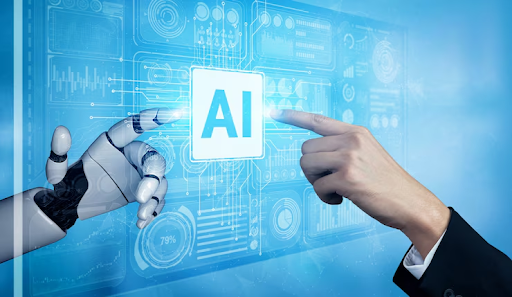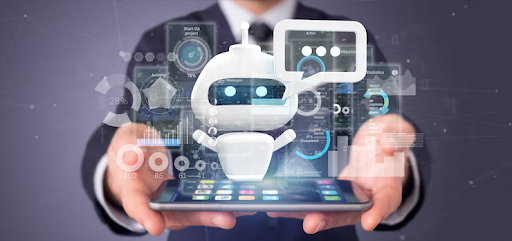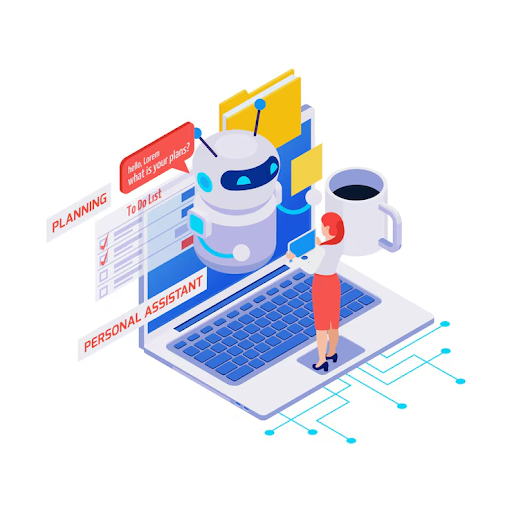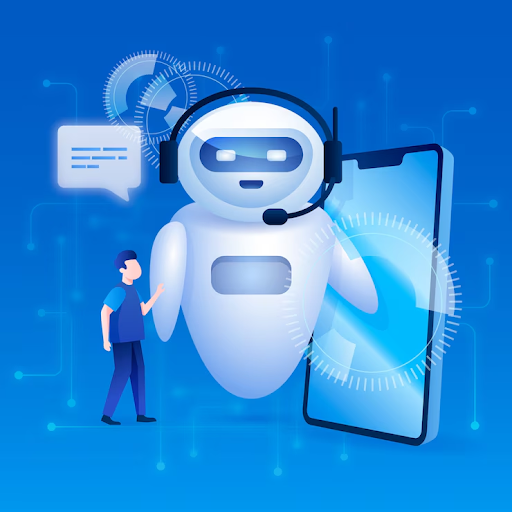In the context of rapid technological advancements, particularly with the rise of Artificial Intelligence (AI), the role of assistants — both human and machine — is undergoing a significant transformation. AI is no longer a foreign concept but has become an essential tool across various sectors such as healthcare, finance, education, and marketing. Notably, AI assistants are progressively replacing repetitive tasks traditionally performed by human assistants, delivering enhanced efficiency, faster turnaround times, and optimized costs. This article will explore the distinctions between traditional assistants and AI assistants, while also analyzing the inevitable shift in the digital age.
1. What is an AI Assistant? Key differences from traditional assistants
An AI assistant is a software system programmed to execute tasks based on artificial intelligence, including:
- Answering inquiries and providing 24/7 customer support via chatbots.
- Automating processes such as scheduling appointments, sending emails, and analyzing data.
- Learning from user data to provide intelligent responses.
- Integrating with various platforms (CRM, Google Workspace, Slack, etc.).
Basic Differences:
| Criteria | Traditional Assistant | AI Assistant |
|---|---|---|
| Nature | Human | Software |
| Working Hours | Limited | 24/7 |
| Ability to Handle Big Data | Limited | Strong |
| Emotions & Social Interaction | Yes | None or Limited |
| Cost | Higher | More Cost-Effective |
2. The superior capabilities of AI assistants compared to traditional assistants

In today's rapidly advancing digital era, AI assistants are increasingly becoming the optimal choice for individuals and businesses seeking to enhance operational efficiency, reduce costs, and improve user experience. Compared to traditional assistants, AI assistants offer several distinct advantages, stemming from their intelligent information processing capabilities, operational flexibility, and rapid adaptability.
Superior information processing and task execution capabilities
AI assistants can process vast amounts of data and execute tasks rapidly, often near-instantaneously. Leveraging their multitasking abilities, AI can handle multiple requests concurrently without compromising performance. Crucially, AI ensures a high degree of accuracy and minimizes errors associated with human factors, leading to smoother and more reliable workflows.
Continuous availability and flexible scalability
Unlike human counterparts, AI assistants can operate continuously on a 24/7 basis, unconstrained by working hours, fatigue, or leave periods. Simultaneously, AI can serve a large volume of users concurrently without impacting quality. Depending on the scale and growth requirements, AI systems can be readily scaled up without necessitating a proportional increase in human resource costs.
Learning and personalization capabilities
AI assistants possess the ability to learn continuously from data and past interactions to refine their performance and relevance. Based on user behavior, history, and preferences, AI can personalize experiences and deliver precise and timely recommendations and support. This fosters a more intelligent and user-friendly experience compared to traditional methods.
Cost savings and enhanced operational efficiency
The implementation of AI assistants significantly reduces personnel, training, operational, and related expenses. Concurrently, AI contributes to increased productivity for both users and the organization by automating processes, reducing wait times, and enhancing overall efficiency.
3. Diverse applications of AI assistants in the digital age

AI assistants are increasingly becoming an indispensable component across various aspects of life and work, owing to their automation capabilities, versatile support, and enhancement of work efficiency. The following highlights the prominent applications of AI assistants in diverse environments:
In a Business Environment:
- Customer Support: AI assistants, particularly chatbots, can promptly address customer inquiries, resolve issues, and provide 24/7 support, thereby alleviating workload on human staff and improving customer experience.
- Schedule and Meeting Management: AI assistants facilitate the management and arrangement of meetings, send reminders, and update schedules for employees within the organization, ensuring no critical appointments are missed.
- Document and Information Organization: AI can automatically organize, categorize, and store documents, enabling businesses to save time on information retrieval and processing.
- Execution of Repetitive Office Tasks: AI assistants can automate administrative tasks such as data entry, report generation, and template-based email correspondence, allowing employees to focus on more creative endeavors.
- Human Resources Support: AI can assist in the recruitment process by filtering applications and identifying suitable candidates, as well as supporting the onboarding of new employees.
In the Healthcare Sector:
- Patient Support: AI assistants can aid patients in scheduling appointments, providing medication reminders, or monitoring their health conditions as required.
- Provision of Basic Medical Information: AI can offer information on common ailments, treatment methods, and preventive measures, helping patients learn and enhance their health literacy.
- Doctor Assistance: AI assistants can support physicians in diagnosis and treatment processes by analyzing test results, offering advice on treatment protocols, and even predicting potential health risks.
In the Education Field:
- Virtual Teaching Assistants: AI assistants can function as virtual teaching assistants, answering student queries, providing learning materials, and offering support throughout the learning process.
- Personalized Learning Paths: AI can develop individualized learning paths based on each student's needs, abilities, and learning pace, enabling more effective knowledge acquisition.
- Provision of Materials and Exercises: AI assistants can automatically supply relevant learning materials and exercises tailored to individual students, thereby enhancing learning quality and fostering a flexible learning environment.
In Daily Life:
- Virtual Assistants on Smartphones and Smart Speakers: Virtual assistants such as Siri, Google Assistant, and Alexa help users perform daily tasks like information retrieval, scheduling, and controlling smart home devices (lighting, temperature, music, etc.).
- Support for Information Retrieval and Device Control: AI assistants can quickly search for information on the internet or easily control household appliances like televisions, refrigerators, and washing machines via voice commands.
Thanks to their automation, personalization, and continuous learning capabilities, AI assistants are becoming a powerful tool across numerous sectors, from business, healthcare, and education to everyday life, contributing to time savings, enhanced work efficiency, and improved user experiences.
3. Challenges and limitations of AI assistants

While AI assistants offer numerous benefits and broad applications across various sectors, there remain significant challenges and limitations that require addressing. Key issues include:
Lack of creativity and critical thinking:
AI assistants primarily operate based on pre-existing data and programmed algorithms. Although AI can process and analyze information with speed and accuracy, it lacks the inherent creativity and critical thinking abilities of humans. AI struggles to solve complex problems demanding flexible thinking, deep reasoning, or the generation of novel and innovative solutions in unprecedented situations.
Limitations in emotional intelligence and human understanding:
A major weakness of current AI assistants lies in their limited emotional intelligence. While AI can process language and recognize patterns, it still encounters difficulties in comprehending and analyzing the nuances of emotions and underlying intentions in communication. This restricts AI's ability to interact with humans naturally and understand users' implicit feelings or needs, consequently impacting relationship building.
Security and privacy concerns:
The utilization of AI often involves the collection and processing of personal data, ranging from behavioral patterns to sensitive information. This raises concerns regarding user security and privacy. AI systems must adhere to stringent security regulations and standards to safeguard personal information and prevent risks such as cyberattacks, data breaches, or misuse.
Infrastructure requirements and deployment costs:
Deploying AI assistant systems necessitates a robust technological infrastructure and substantial investment for businesses or organizations. The system requires continuous development, maintenance, and optimization, demanding a team of experienced technology experts and developers. This can pose challenges for small and medium-sized enterprises (SMEs) seeking to adopt AI technology due to the high initial deployment costs.
Risk of job displacement:
A significant concern associated with the implementation of AI assistants is the potential for human job displacement. In certain sectors, AI can automate repetitive tasks and even those requiring basic skills. This generates anxieties about job losses and widening income inequality. Addressing this issue requires retraining and upskilling programs for the workforce, enabling them to adapt to new roles that demand creative thinking and problem-solving abilities.
In conclusion, while AI assistants present considerable potential across various domains, the challenges related to creativity, emotional intelligence, security, costs, and the risk of job displacement must be comprehensively addressed to fully realize the future potential of this technology.
4. The future of assistance: the synergy between AI and humans

Looking ahead, Artificial Intelligence (AI) will transcend its role as a mere replacement for human labor, evolving into a powerful assistant that supports individuals across a multitude of tasks, thereby enhancing efficiency and fostering greater innovation. The collaborative partnership between AI and human capabilities will forge a hybrid working model, capitalizing on the distinct strengths of both.
AI as a Support, Not a Substitute
Rather than enacting a complete substitution, AI will function as a robust support tool, liberating human professionals from repetitive and time-consuming duties. AI can automate processes such as data classification, address routine inquiries, and manage common requests. This will empower individuals to concentrate on tasks demanding creativity, strategic thinking, and interpersonal engagement – domains where human intellect continues to hold an irreplaceable advantage.
The "Hybrid Assistant" Paradigm
The "hybrid assistant" paradigm is poised to become increasingly prevalent in the future, wherein AI assistants and human assistants collaborate to optimize workflows. AI assistants can handle repetitive tasks, analyze data, and automate administrative functions, while human counterparts will focus on strategic decision-making, fostering innovation, and cultivating client relationships. This synergy will not only yield time savings but also elevate the quality of work output.
Emerging roles and professions driven by AI advancement
The rapid advancement of AI will catalyze the creation of numerous novel roles and professions. Specialists in the development, deployment, and management of AI systems will become pivotal assets within organizations. Furthermore, there will be a growing demand for roles centered around AI training and interaction, such as training AI models to enhance their comprehension and accuracy in responding to user needs.
The imperative of human training and upskilling
In the AI-driven era, the retraining and upskilling of the workforce assume paramount importance. Soft skills such as communication, leadership, creativity, and higher-order cognitive abilities will be crucial for individuals to collaborate effectively with AI. Moreover, adapting to the evolving demands of the labor market will necessitate flexibility and a commitment to continuous learning among employees, ensuring their relevance in the digital age.
5. Conclusion
In the age of artificial intelligence, AI assistants are increasingly replacing traditional assistants due to their ability to process information rapidly, automate repetitive tasks, and provide 24/7 support. Beyond enhancing business efficiency and yielding time and cost savings, AI unlocks novel opportunities in product development, customer service enhancement, and workflow optimization. While challenges such as a lack of creativity and emotional intelligence persist, the future of AI assistants promises a synergistic collaboration between humans and machines, enabling individuals to concentrate on creative and strategic endeavors. With the continuous advancement of technology, AI assistants will continue to demonstrate their pivotal role in transforming work practices and elevating the quality of life across all sectors.